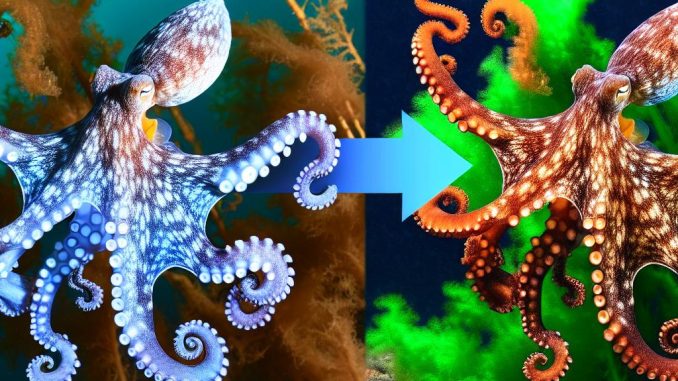
Understanding Octopus Color Change
Octopuses are fascinating marine creatures known for their incredible ability to change color almost instantaneously. This remarkable feature plays a vital role in their survival, aiding in predation, communication, and camouflage. The interplay between their physiological makeup and environmental interactions makes them a subject of significant interest in marine biology.
Mechanisms Behind the Color Change
Octopuses owe their color-changing capabilities to specialized skin cells. These cells are primarily chromatophores, iridophores, and leucophores, each contributing uniquely to the process of altering color, thus allowing a range of visual effects that are essential for various survival strategies.
Chromatophores are pigment-containing cells that expand or contract to show or hide different colors. These cells contain sacs of pigments like black, brown, red, orange, or yellow, and are controlled by the octopus’s nervous system. By rapidly expanding or contracting these sacs, octopuses can modify their skin color to match their environment, a process that can be triggered within milliseconds. This rapid response is essential for both predation and evasion.
Iridophores are reflective cells that refract light into different colors, much like the way oil reflects light in a puddle. They can produce a range of bright, iridescent colors, contributing to the octopus’s ability to adapt its appearance to underwater surroundings. These structural colors result from the microscopic layers of these cells, which interact with light through a process known as constructive interference.
Leucophores reflect ambient light and are often responsible for producing white or pale colors. They provide a contrasting background, which can enhance the effect of chromatophores. By reflecting the predominant wavelengths of light in their environment, leucophores can help the octopus remain visually inconspicuous against various backgrounds, enhancing its ability to blend in seamlessly.
The Role of the Nervous System
The octopus’s nervous system plays a critical role in controlling the color change. Unlike humans, where color perception is processed primarily in the brain, octopuses can process this information directly on their skin as part of a complex reflex action. Neurons embedded in their skin detect environmental changes, allowing the octopus to adapt its appearance quickly and efficiently without relying solely on centralized brain processing.
This neurological setup indicates a decentralized nervous system, which provides an efficient and rapid response mechanism to environmental stimuli. The direct interface between neurons and skin cells enables the octopus to adjust its camouflage on the fly, reacting to the presence of predators or sudden changes in habitat with remarkable speed.
Functions of Color Change
The ability to change color serves multiple purposes for octopuses. Primarily, it provides camouflage to avoid predators by blending seamlessly into their surroundings. This process goes beyond mere color alteration to include changes in skin texture, allowing octopuses to mimic rocks, coral, or other marine life. This comprehensive disguise technique is a critical survival mechanism in the diverse and often perilous marine environment.
Communication is another crucial aspect, as octopuses can convey signals to others of their kind through different patterns and colors. During mating rituals or territorial disputes, specific patterns and hues can communicate readiness to mate, aggression, or submission. This visual communication is vital in their social interactions, given their solitary nature otherwise.
Furthermore, certain color patterns can also act as a defense mechanism, warning potential predators of danger or toxicity. A sudden display of bright colors can deter predators by either mimicking other toxic species or standing out conspicuously in a visual warning display, a phenomenon known as aposematism.
Research and Implications
Current research explores how these color-changing capabilities can inspire technological advancements. Scientists are investigating the application of octopus chromatophore principles in developing advanced materials and technologies. These might include dynamic camouflage fabrics for military use, where troops could benefit from the natural stealth derived from such biological systems.
Moreover, the vibrant, adaptable colors produced by octopuses have potential applications in creating enhanced optical devices or even responsive display screens. Engineers and designers seek to replicate the principles of light manipulation seen in iridophores for use in electronic displays or color-shifting materials. This could revolutionize how we interact with visual technology in daily life, making it more responsive and adaptable.
Understanding octopus color change is not just a study of marine biology but also an intersection of biology, technology, and innovation, showcasing the remarkable adaptability and complexity of these intelligent sea creatures. The exploration of this natural phenomenon continues to drive research and inspire innovations across various fields, highlighting the potential for cross-disciplinary applications derived from understanding nature’s intricacies.
Analyzing these processes not only deepens our knowledge of marine life but also fosters a broader appreciation of the sophisticated biological systems evolved over millions of years. These insights can lead to sustainable innovations, offering solutions that align with nature’s efficiency and sustainability principles.
For more insights into marine biology and technological inspirations from nature, visit MarineBio.
